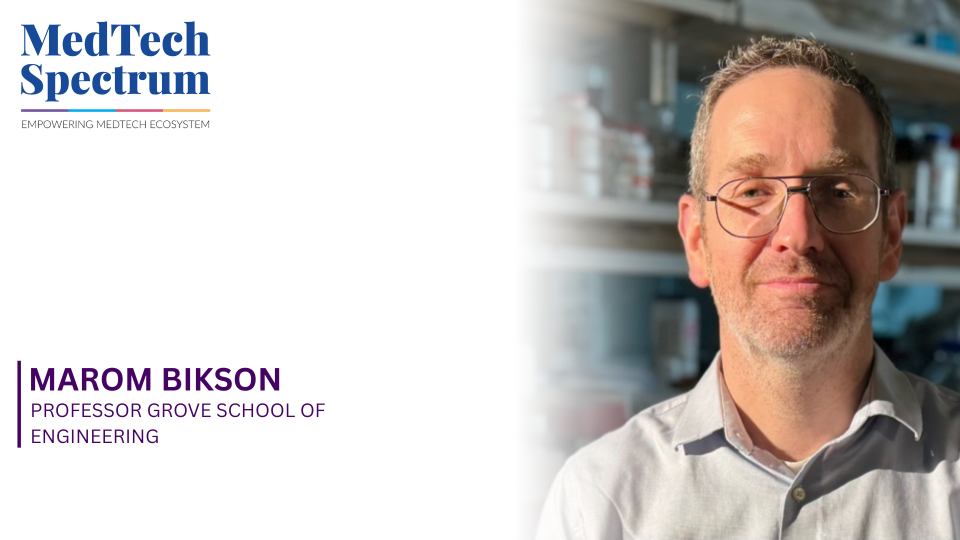
Electrotherapy has always stood at the edge of mainstream medicine, clinically promising, but too often held back by cumbersome devices, limited usability, and patient resistance. A team at the Grove School of Engineering is rewriting that story. Led by Professor Marom Bikson, a global authority in neuromodulation, researchers have developed a first-of-its-kind technology: Wearable Disposable Electrotherapy.
Unlike traditional electrical stimulation devices powered by batteries and electronics, these new patches are paper-thin, single-use, and completely electronics-free. Activated by skin contact, they generate a controlled therapeutic dose using printed layers of mineral-based materials—bringing the simplicity of a drug patch to the world of electrotherapy.
The implications are sweeping: faster wound healing, non-invasive brain stimulation for depression and migraine, and even needle-free drug delivery, all with a low-cost, eco-conscious design that could scale globally.
MedTech Spectrum spoke with Professor Bikson about the science behind this breakthrough, the challenges of reinventing electrotherapy from the ground up, and how this platform may signal a new era of wearable medicine.
What inspired the development of the "Wearable Disposable Electrotherapy" concept, and how did your team first envision electronic-free wearable medicine?
There are many medical conditions where drug therapy is either not sufficiently effective or associated with side-effects. As an alternative to pharmacotherapy, patients and providers consider electrotherapy but existing devices are cumbersome to use. Wearable Disposable Electrotherapy combines the special benefit of electrotherapy with the usability of pharmacotherapy.
The patches are described as single-use, battery-free, and electronics-free. Could you explain the mechanism by which they generate and deliver therapeutic energy without traditional power components?
All prior electrotherapy devices controlled the delivery of electrical therapy using packaged batteries and electronics. Since our goal was a single-use device that was environmentally-benign and cheap, we invented an electronics-free electrotherapy delivery system. While each device is only a millimeter thick, it is made of a network of electrochemical components that are activated upon device application to the skin. This novel electrochemical structure regulates its delivery of a single controlled dose. Also, by relying only on abundant materials and scalable printing techniques for manufacturing devices, cost is minimal.
Your paper highlights applications ranging from wound healing to neurological therapy and drug delivery. Which of these areas do you see as the most promising for near-term clinical translation?
Wearable Disposable Electrotherapy is a platform that can be tuned to many electrotherapy applications. There are three use-cases that we are currently focused on for clinical translation. First, we showed how Wearable Disposable Electrotherapy bandages can accelerate wound heading, reduce infection, and minimize complications. Clinical trials will start with post-surgical wound care. Second, Wearable Disposable Electrotherapy patches applied to the forehead will be trialed for depression and migraine treatment. This is essentially brain stimulation but with single use strips. Third, Wearable Disposable Electrotherapy can be for delivering drugs through skin without needles.
Environmental sustainability is an important consideration for single-use devices. How did your team ensure the materials used in these patches are safe and eco-friendly?
This consideration is central to our design, we set out from the beginning to build a product that is environmentally conscious. The innovation lies in how we re-engineered the entire electrotherapy platform around simple, inert, mineral-based materials. We use only microgram quantities of naturally occurring, environmentally safe minerals, structured into thin printed layers to create a fully functional electrotherapy patch. Because the device operates without any electronics and relies on low-impact manufacturing methods, its footprint is dramatically lower than that of conventional electrotherapy systems. In contrast, current devices depend on single-use electrodes combined with electronic housings, batteries, and high-carbon fabrication processes. Our approach replaces all of this with a clean, minimal, and eco-conscious design.
What challenges did you face in designing a device that successfully integrates chemical, electrical, and biomedical principles while remaining simple enough for disposable, everyday use?
The design process of such devices took the better half of a decade to successfully iterate into what we are able to present today. The design process is recursive in many ways with innovations at each step leading to changes and improvements in other steps. In addition to that, taking into account the patient experience,practicality of therapy distribution, and manufacturing cost together the development of this platform was extremely complicated.
Looking ahead, what are the next steps for this technology—are there plans for clinical trials, partnerships with medical device companies, or commercial development?
The technology will be commercialized through our new venture, Wearable Medicine. Clinical trials are ongoing to validate the technology for specific use cases. We look forward to new partnerships with investors and companies that recognise the category-defining Wearable Disposable Electrotherapy - the first medical technology to combine the benefits of pharmacotherapy and electrotherapy.